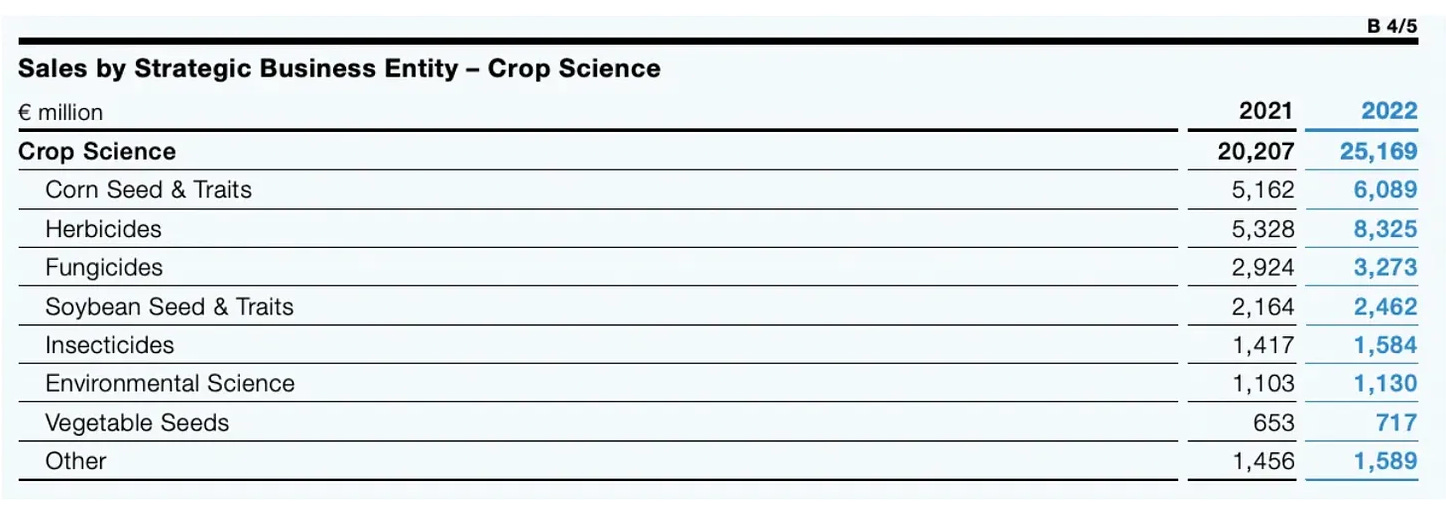Bayer Crop Science FY 2022 Results and Annual Report - Bayer
2022 was a record year for Bayer Crop Science, surpassing €25 billion in sales with 15.6% sales growth.
While strong, there are a couple contributors worth noting. Check out their financials for FY 2022 and note the volume, price and currency for contributions to that growth:
Volume was flat. Price increase and favourable currency exchange made up the bulk of the growth.
On top, roughly two-thirds of the sales growth or approximately €2 billion, came from higher glyphosate pricing due to the tight global supply.
Their revenue broke out by segment as such:
2022 was a record year, but they are unlikely to see the same growth for two reasons: lower price growth and a constriction in glyphosate pricing.
Overall, Bayer is expecting to grow Crop Science sales by around 3%, with glyphosate-based herbicide sales declining by roughly 15-20%, or approximately €900 million while the rest of the division sales grow by approximately 8%, mostly from pricing.
For glyphosate specifically, Bayer is anticipating that prices will continue to normalize, though not quite back to 2021 levels.
Fungicides and insecticides each delivered 5% sales growth and the rest of the herbicide portfolio grew by 11%.
The global corn business grew its share position in the market, delivering nearly 9% sales growth. In the US, stronger pricing offset the lower planted corn acres and a decline in royalties from some older licences.
In other geographic regions, Bayer achieved growth rates in corn of 20% or more based on a combination of volume gains and price increases.
In soybean, despite flat global sales, maintained their #1 position globally with more than 80% of the acres in Brazil and close to 50% of the acres in the US with their trait technologies.
What did stand out as well was the EBIDTA margin of 27% (before special items). This is one of the strongest in the industry. For 2023, Bayer has an expected margin in the range of 25% to 26% at constant currencies, a subtle decline from 2022. For context, Corteva runs at an EBITDA margin of around not quite 20%, FMC has around 26% and BASF comes in around 20%.
Research and Development
Bayer had an R&D investment of €2.6 billion in 2022 and has >7,000 employees working on R&D alone.
This brings them in at almost exactly 10% of revenue, consistent to slightly ahead of the other major manufacturers. Syngenta and Corteva have been just under 10% lately while BASF has been just around 11% the last couple years.
Given that Bayer is the largest seed company and the 2nd largest in crop protection revenue, this gives them an edge as it pertains to absolute investment in R&D. In the short term, this may not be that notable. But if it persists for the long term and they are effective with their R&D expenditures, then it theoretically gives them an edge in innovation and new product development.
It is worth noting that 2022 was the 5th consecutive year of decline in R&D expenditure as a percentage of sales.
This has been a trend with almost all ag incumbents. Less R&D expenditure compared to 15 - 20 years ago, seemingly in an effort to be able to increase profits, or dividends, to attract investors. There is nothing inherently wrong with this, but makes me wonder if it will ever reverse. It seems to me like there hasn’t been one specific thing for companies to get excited about in allocating their R&D dollars to.
I have suggested in the past it could be a lack of confidence in the R&D capability, but I think that’s incorrect as a general statement. I think more simply is that it can look bad to investors, specifically when trying to compete for capital, spending on R&D and taking a shot gun approach and having very little to show for it.
If we go back to the biotech hay-day when R&D was consistently around 12-13% of revenue for ag inputs companies, there were very explicit areas of biotech and traits that were going to show good returns and competitive in roads in the market place.




